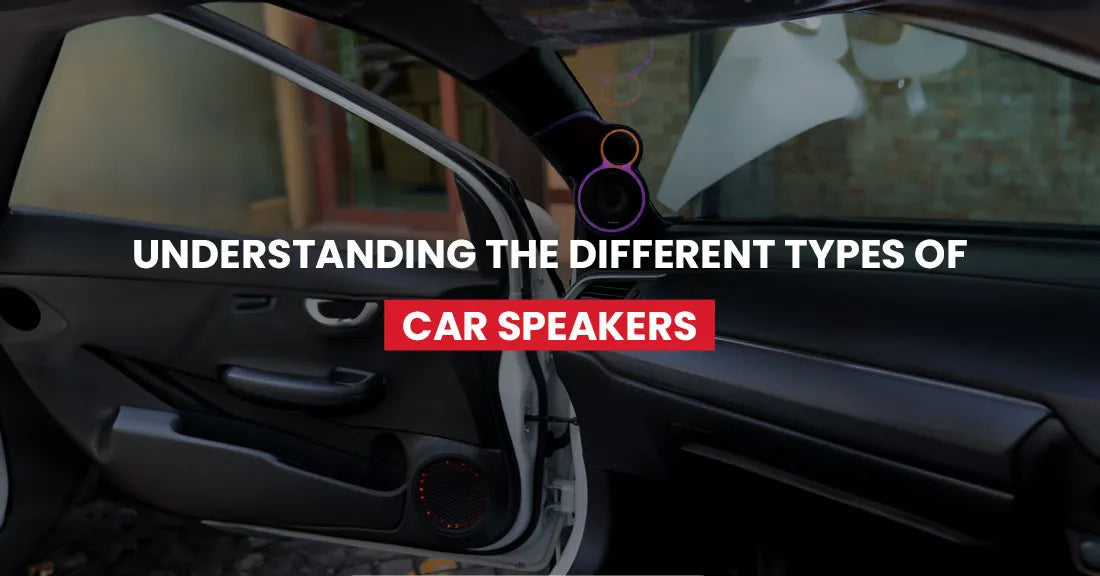
Understanding the Different Types of Car Speakers
When it comes to enhancing your car's audio experience, the quality and type of speakers play a pivotal role. With the growing interest in in-car entertainment systems, car speakers have evolved far beyond basic factory models. In this blog, we will explore the different types of car speakers, their functions, benefits, and how to choose the right ones for your vehicle.
1. Coaxial Speakers (Full-Range Speakers)
Coaxial speakers are the most common type found in vehicles. They combine multiple speaker elements into one unit, including a woofer for low frequencies and a tweeter for high frequencies. Some models even include mid-range drivers.

Pros:
- Affordable and easy to install.
- Good all-around sound quality.
- Ideal for users who want an upgrade from factory-installed speakers.
Cons:
- Not as customizable as component systems.
- May lack audio depth compared to separate units.
2. Component Speakers
Component speakers consist of separate woofers, tweeters, and crossovers. This separation allows for better sound distribution and overall clarity.
Pros:
- Superior sound quality.
- Customizable placement of components.
- Ideal for audiophiles.
Cons:
- More expensive.
- Installation is complex and may require professional help.
3. Subwoofers
Subwoofers handle the lowest frequencies, adding depth and bass to your car audio system. They range in size from 8 to 15 inches and are often housed in dedicated enclosures.

Pros:
- Powerful bass response.
- Ideal for music genres like EDM, hip-hop, and rock.
Cons:
- Can take up trunk space.
- Requires an amplifier for optimal performance.
4. Midrange Speakers
Midrange speakers are designed to handle frequencies between 250 Hz and 2000 Hz. They provide the vocals and instrumentals in your music.
Pros:
- Balanced sound when paired with subwoofers and tweeters.
- Enhances clarity of vocals and instruments.
Cons:
- Cannot handle very high or very low frequencies.
- Best used as part of a multi-component system.
5. Tweeters
Tweeters produce high-frequency sounds (2,000 Hz to 20,000 Hz), essential for treble clarity. These are typically mounted on the dashboard or door panels.
Pros:
- Clear and crisp highs.
- Essential for a full-range sound profile.
Cons:
- It can sound harsh without proper tuning.
6. Super Tweeters and Horn Tweeters
For audio enthusiasts who crave the highest clarity, super tweeters and horn tweeters push the upper limits of frequency response.
Pros:
- Ultra-clear treble.
- Ideal for large vehicles or custom setups.
Cons:
- Typically used in competitions or high-end installations.
Choosing the Right Speakers
Here are a few factors to consider before investing in new car speakers:
- Power Handling: Measured in watts RMS, this indicates how much power the speakers can handle continuously.
- Sensitivity: High-sensitivity speakers are ideal for low-powered car stereos.
- Material: Cone material affects sound quality and durability.
- Impedance: Typically, 4-ohm speakers are standard, but some systems support 2-ohm or 8-ohm for specific performance tuning.
Trends and Analytics in the Car Audio Market
According to a 2024 report by MarketsandMarkets, the global car audio market is expected to grow at a CAGR of 6.3%, reaching $13.5 billion by 2030. Factors influencing this growth include:
- Rising demand for infotainment systems.
- Increasing preference for customized audio solutions.
- Growth of electric vehicles offering more quiet cabins, demanding high-fidelity sound systems.
Online platforms, like RD Overseas, offer a wide range of general audio components that cater to varied customer needs without pushing one specific brand, making them a go-to destination for quality and variety.
Upgrading your car's sound system starts with understanding the types of car speakers available. Whether you’re looking for a simple improvement or aiming to build a premium soundstage, knowing the roles of woofers, tweeters, subwoofers, and component setups helps you make an informed choice.



